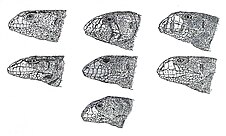Polyglyphanodontia
| Polyglyphanodontia Temporal range: Early Cretaceous-Late Cretaceous,
| |
|---|---|

| |
| Skeleton of the polyglyphanodontian Polyglyphanodon sternbergi | |
| Scientific classification | |
| Domain: | Eukaryota |
| Kingdom: | Animalia |
| Phylum: | Chordata |
| Class: | Reptilia |
| Order: | Squamata |
| Clade: | Scincogekkonomorpha |
| Clade: | †Polyglyphanodontia Alifanov, 2000 |
| Synonyms | |
| |
Polyglyphanodontia, also known as the Borioteiioidea, is an extinct clade of Cretaceous lizards. Polyglyphanodontians were the dominant group of lizards in North America[1] and Asia[2] during the Late Cretaceous.
Chronology and distribution
Most polyglyphanodontians are Late Cretaceous in age, with the highest diversity in the group being known from East Asia.
Ecology
Polyglyphanodontians were morphologically diverse. Chamopsiids, including Chamops, from North America have tricuspid teeth, and were generally small in size. Members of the family Polyglyphanodontidae primarily known from Europe and North America (including Polyglyphanodon, Paraglyphanodon, Dicodon and Bicuspidon) have large teeth that are transversely orientated, and were likely herbivorous as well as possibly ominivorous. The family Gilmoreteiidae have iguana-like teeth, with some polyglyphanodontians known from Asia having conical teeth. Some gilmoreteiids developed a complete lower temporal bar similar to that found in the tuatara, but is otherwise unheard of in lizards.[3]
Classification


The classification of Polyglyphanodontia is contentious. They have been considered to be either most closely related to
| Squamata |
| ||||||||||||||||||||||||||||||||||||||||||||||||
References
- PMID 23236177.
- doi:10.1139/e96-043.
- ^ ISSN 1477-2019.
- .
- S2CID 84446189.
- S2CID 52924052.
- .
